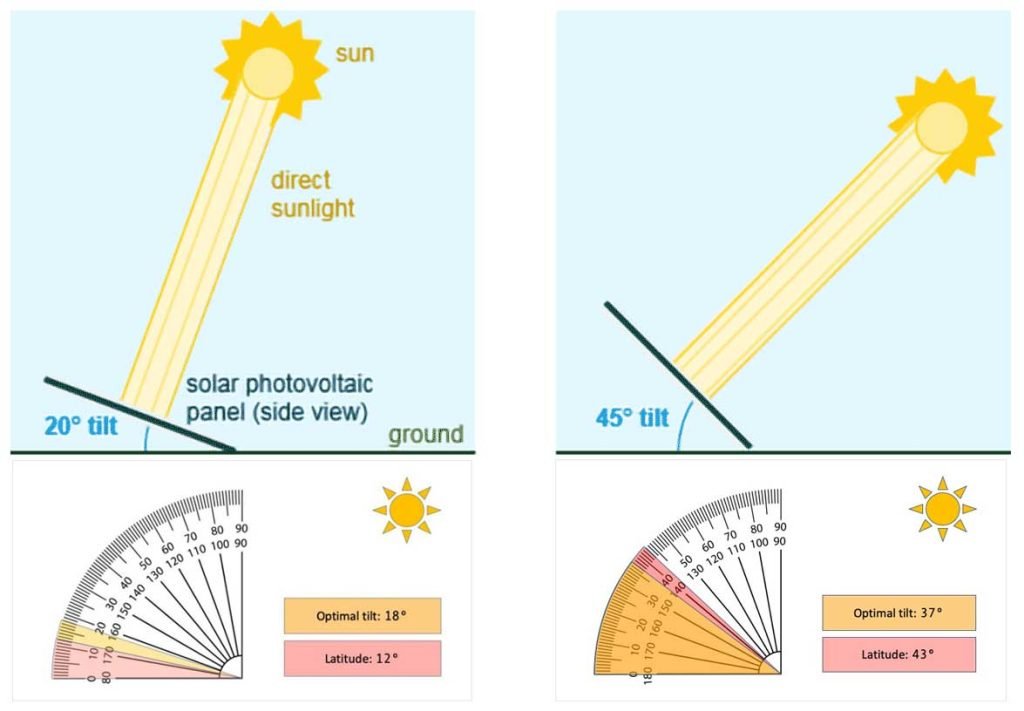1. Basic Principles of Tilt Angle
- Basic Principle: The tilt angle of solar panels is generally set to the local latitude. For instance, Xiamen has a latitude of 24.48 degrees, making the optimal tilt angle for solar panels 24.48 degrees.
- Improvement Principle: In certain regions, particularly low and high latitude areas, the optimal tilt angle might vary slightly. In low latitude areas (0°~35°), the best tilt angle is generally slightly higher than the local latitude. In mid-latitude areas (40°~45°), it closely matches the local latitude, while in high latitude areas (>55°), the optimal angle is typically slightly lower than the local latitude.

2. Calculation Methods for Tilt Angle
2.1 Simple Calculation Based on Latitude
Formula: Optimal Tilt Angle = Local Latitude + Δ
Adjustment Values (Δ):
- Low Latitude Areas (0°~25°): Δ is 5°~10°
- Mid Latitude Areas (26°~40°): Δ is 0°~5°
- High Latitude Areas (41°~55°): Δ is -5°~0°
- Extreme High Latitude Areas (>55°): Δ is -15°~0°
2.2 Precise Calculation Based on Radiation
Formula: R = S * sin(θ + β) + D
R: Global radiation on the arrayS: Daily average direct solar radiation on a horizontal surfaceD: Daily average diffuse radiation on a horizontal surfaceθ: Solar altitude angle at noonβ: Tilt angle of the array with respect to the horizontal plane
3. Practical Application Cases
3.1 Kunming Area (Latitude Approximately 25°)
Optimal Tilt Angle: 30°~35°
Reason: The solar radiation in Kunming is lower in winter, and an increased tilt angle can enhance winter radiation reception, improving the overall system efficiency.
3.2 Xining Area (Latitude Approximately 37°)
Optimal Tilt Angle: 50°
Reason: In Xining, the solar radiation in winter is particularly important, hence a larger tilt angle is chosen to maximize winter radiation reception.
3.3 Nanjing Area (Latitude Approximately 31.14°~32.36°)
Optimal Tilt Angle: 37°
Reason: The solar radiation in Nanjing decreases during winter, and a tilt angle close to the local latitude can balance the energy needs throughout the year.
4. Wind Resistance Design
Solar Panel Bracket Wind Resistance
- Wind Speed Resistance: Above 26 m/s, equivalent to withstanding a typhoon of level ten.
- Connection Method: Use thicker bolt rods for secure connections to ensure stability between the bracket and lamp post.
Lamp Post Wind Resistance
- Bending Strength: The bending strength of steel lamp posts must exceed the stress caused by the wind’s destructive moments.
- Welding Quality: Ensure high welding quality and corrosion treatment at weld joints to avoid damage from wind forces.
5. Installation Considerations
- Installation Direction: Solar panels should face true south (in the Northern Hemisphere) to avoid any shading on the light-receiving side.
- Avoid Interference: There should not be any direct light sources above the panel besides sunlight to prevent control system malfunction.
- Testing: Before hanging the lamp, test each unit with a battery to ensure they illuminate correctly.
- Controller Wiring: Position controller terminals downward to prevent corrosion and short circuits from rainwater along the wires.
- Wiring Sequence: Connect the battery first, then the solar panels, and finally the load. Reverse this order for disassembly.
6. Conclusion
The tilt angle installation of solar street lights must consider local latitude, solar radiation, climatic conditions, and wind resistance requirements. Through reasonable design and installation, the overall efficiency and reliability of the system can be enhanced, ensuring optimal performance of solar street lights throughout different seasons. We hope this guide is helpful for overseas engineers and designers.
